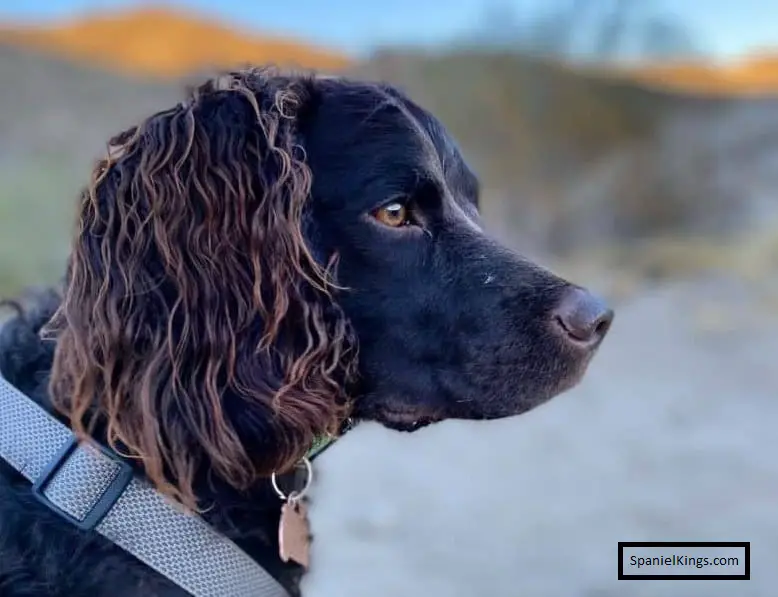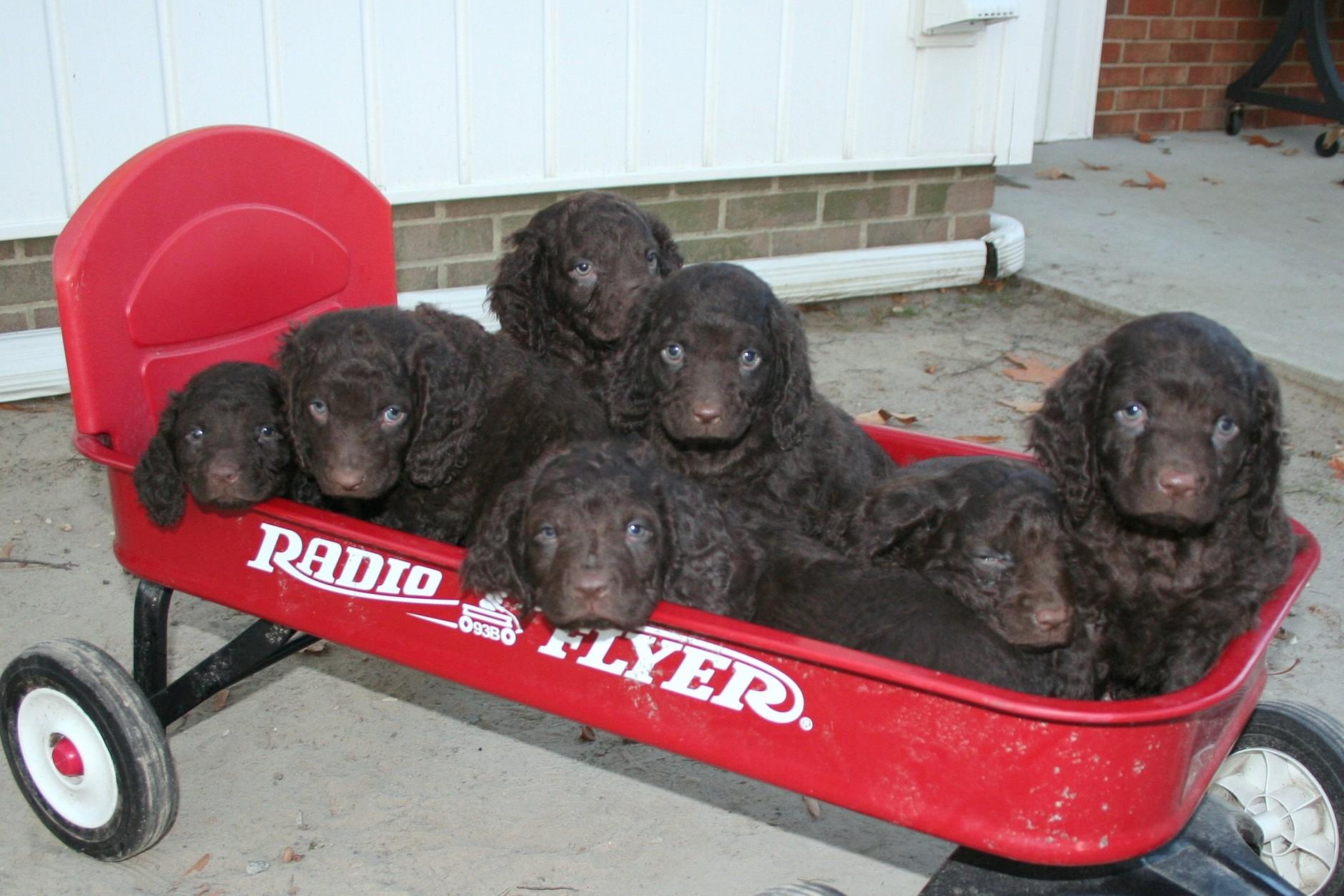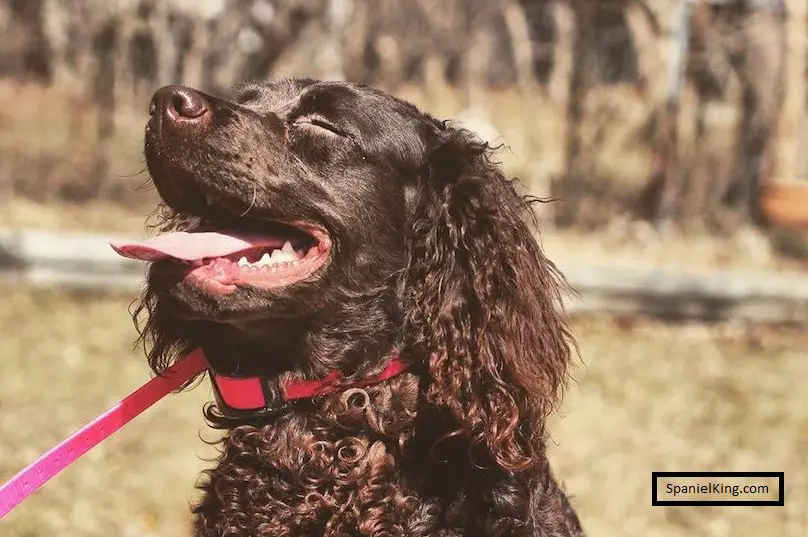Table of Contents
The American Water Spaniel Dog Profile
The American Water Spaniel is a competent dog despite its small size. The muzzle of this breed is long and strong enough to carry a large goose, and the quarters are strong enough to propel the bird through water and overland.
Cocker is somewhat longer than tall, well-built, and muscular. With the explicit dense undercoat, this can range from unvarying waves (marcel) to close curls.

The combination gives protection in opposition to weather, water, or even briars. The ears are well-covered with hair, which is prohibited from growing in the ear canal. The gait is balanced, with a good combination of reach and drive.
Read More about:
Complete List of 24 Spaniel Breeds
American Water Spaniel Highlights
- American Water Spaniels are an energetic breed that needs daily exercise. Permit him to walk one to two hours per day, runs, or fetch games. You can spread out your exercise time throughout the day — an hour here, a half-hour there. Consequently, they may vent their pent-up energy through excessive barking and chewing.
- American Water Spaniels love to roam and may leave the yard or side to proceed in hunting at their own pace if they are not bounded by a fence or no dog’s strap around them.
- This breed can become a companion of a specific person but always consider being friendly with other family members. Do not anticipate them to praise a visitor or strangers.
- Grating treatment towards them can result in timidness or stubbornness. When there is a gentle touch and training practices accompanied by prizes, the breed can respond the best.
- Notwithstanding the fact that this breed is friendly to other family dogs and pets, they are territorial and hostile with unfamiliar dogs.
- American Water Spaniels can have a natural propensity for chewing, digging, and jumping; however, these behaviors can be controlled with some training pieces.
- Do not purchase from an unwise breeder, puppy mill, or pet shop in considering getting a healthy dog. Select a legitimate breeder who examines her breeding dogs to assure that they do not have genetic diseases that can be contagious to other puppies and have sound temperaments.
American Water Spaniel Breed Features & Ratings:
Overall
Total Score
American Water Spaniel Breed Features & Ratings:
Rated base on a 5 Star Scale
ENERGY LEVEL: 4 Star
EXERCISE REQUIREMENTS: 3 Star
PLAYFULNESS: 4 Star
AFFECTION LEVEL: 3 Star
FRIENDLINESS TO DOGS: 2 Star
FRIENDLINESS TO OTHER PETS: 3 Star
FRIENDLINESS TO STRANGERS: 2 Star
WATCHFULNESS: 3 Star
EASE OF TRAINING: 3 Star
GROOMING REQUIREMENTS: 3 Star
HEAT SENSITIVITY: 3 Star
VOCALITY 4 Star
American Water Spaniel Breed Profile:
Dog Breed Group: Sporting Dogs
Height: At the shoulder, they range in height from 1 foot 3 inches to 1 foot 6 inches.
Weight: 25 to 45 pounds
Life Span: 12-15 years
Type Purebred
AREA OF ORIGIN: United States
DATE OF ORIGIN: 1800s
OTHER NAMES: AWS, American Brown Spaniel, American Brown Water Spaniel
Temperament:
Energetic
Friendly
Intelligent
Obedient
Protective
Trainable
Activities: Field Trials, Hunting, Agility, Rally, Conformation, Obedience, Therapy
Litter Size
4-6 puppies
Puppy Prices
Average $1200 – $1500 USD
The American Water Spaniel continues to be a one-of-a-kind breed. The average price for this breed from a legitimate, wise, and educated breeder ranges between $1,200 – $1,500.
American Water Spaniel Health:
As is the case with all breeds, most American Water Spaniels will live a long and healthy life if provided with proper care and regular veterinarian visits. A responsible breeder will undergo breeding stock for hip dysplasia, eye disorders, cardiac abnormalities, and degenerative myelopathy.
- Major concerns: mitral valve disease
- Minor concerns: PDA, pulmonic stenosis, CHD
- Occasionally seen: patellar luxation, PRA
- Suggested tests: cardiac, hip, eye
- Life span: 10–12 years
- Hip Dysplasia: Hip osteoarthritis is a degenerative disease in which the hip joint becomes enfeeble due to abnormal growth and development. This condition affects many dog breeds, not solely the American Water Spaniel.
- Growth Hormone-Responsive Dermatitis: It results in changes to the skin due to a deficiency of growth hormone (somatropin). The pituitary gland produces this hormone, which is essential for hair growth. Affected animals lose hair in varying degrees but remain otherwise healthy. It is unknown how inheritance occurs. This condition can be seen commonly in 1 to 5 years old dogs, with hair loss happening at puberty. Hair loss is symmetrical throughout the dog’s body, and the skin becomes noticeably darker in color due to increased pigmentation. Without treatment, baldness and hyperpigmentation will eventually spread to all body areas except the head and feet. It is possible to treat it with growth hormone, but this is expensive and difficult to obtain. Male dogs may be cured of the condition through neutering.
- Pattern Baldness (Saddle Alopecia): This condition results in a gradual, symmetrical thinning and loss of hair (alopecia), which typically starts in the ages of 6 and 9 months and advances until the affected areas are completely bald. Hair loss occurs beneath the neck, on the back of the thighs, and on the tail with saddle alopecia. The mechanism of inheritance is unknown. Hair loss does not have a treatment available to compensate.
- Cataracts: A cataract is a lack of transparency on the lens of the eye that impairs vision. The dog’s eye(s) will appear blurry. Cataracts typically develop in old age and can be removed surgically.
- Retinal Dysplasia: Retinal Dysplasia is a condition in which the retina develops abnormally, causing retinal folds. It can result in many vision problems for the dog, from a small blind spot to complete blindness. Despite being frequently noticed as a hereditary disease, it can also root in various environmental factors, including trauma. Although there is no known cure for Retinal Dysplasia, numerous dogs with the condition lead everyday lives, and their other senses make up for the loss of vision.
- Allergies: Allergies are a prevalent problem in dogs. Allergies to specific foods are identified and treated by temporarily removing the offending foods from the dog’s diet. Contact allergies develop when an allergen comes into contact with the dog, such as bedding, flea powders, dog shampoos, or other chemicals. Furthermore, these are also treated by determining and eliminating the allergen’s source. Inhalant allergies are caused by allergens in the air, such as pollen, dust, and mildew. The severity of the allergy determines the medication that is most appropriate for inhalant allergies. Ear infections are a frequent complication of inhaled allergen allergies.
- Progressive Retinal Atrophy (PRA): This is a progressive eye disease that affects a wide variety of breeds. Blindness caused by PRA is a progressive condition that occurs due to the loss of photoreceptors in the back of the eye. Years before, the dog exhibits any signs of blindness, and PRA is detectable. Each year, legitimate breeders have the eyes of their dogs Veterinary ophthalmologist-certified.
- Epilepsy: A condition that results in seizures in dogs. Epilepsy is treatable with medication, but there is no cure for it. With careful management of this disorder, a dog can live a long, happy, and healthy life.
- Hypothyroidism: Hypothyroidism: Hypothyroidism is caused by a thyroid hormone deficiency produced by the thyroid gland in the neck. Infertility is one of the disease’s mild symptoms. Obesity, mental dullness, lethargy, drooping eyelids, low energy levels, and irregular heat cycles are the more visible symptoms of this disease. The dog’s fur becomes coarse and brittle, falling out, and the skin becomes tough and dark. It is treatable with daily thyroid replacement therapy and typically requires lifelong treatment. A dog receiving daily treatment has the potential to live a whole and happy life.
American Water Spaniel Grooming:
American Water Spaniel’ coat is dense, waterproof, and curled or wavy. The breed was developed to work in the icy waters of the Great Lakes region, where its insulating, double-layer coat enables its insulating, double-layer coat. Every week grooming is necessary, but it is a relatively straightforward process. Summer coats are sparser and can be shaped with a rubber-tipped pin brush. Throughout the year, especially during shedding season, use a slicker brush to remove dead hair from the undercoat. As with all breeds, the nails of the American Water Spaniel should be trimmed on a regular basis.
American Water Spaniel is known as a double-coated dog. The American Water Spaniel’s dense undercoat protects him from the elements, water, and scratchy underbrush. Furthermore, the outer coat may have uniform waves, referred to as a marcel coat, or it may have tight curls. The number of curls or waves varies according to the area of the dog’s body. The forehead is protected in short, smooth hair, and the tail and legs have moderate feathering.
The breed’s coat can be solid liver, brown, or dark chocolate and every so often toes or chest can have a little amount of white.
Certain hunters clip their coats to make burr removal easier. Family dogs can be left alone, or you can trim the coat and shave the ears to improve the dog’s appearance. Because the coat is naturally oily to aid in water resistance, oily spots on your wall or furniture may occur if the dog rubs up against them. Weekly brushing will keep the coat in good condition.
Although Water Spaniels shed in the spring, frequent brushing helps prevent excessive loose hair from piling up on carpets and furniture. Regular baths strip the coat of its natural oils, reducing its ability to repel water and keep the dog warm; therefore, bath him only when he is filthy or smelly and genuinely requires to take.
Ear infections are common in all breeds with pendant or hanging ears. Every week, check your American Water Spaniel’s ears and use a clean cotton ball moistened with a veterinarian-recommended cleanser to remove them. Do not put cotton swabs or any others into the ear canal, as this can cause permanent damage. If the inside of your American Water Spaniel ear is odorous, appears red or tender, or if he often shakes his head or scratches at his ear, he may have shown the symptoms of an ear infection.
Brush your dog’s teeth no less than twice or three times a week to extract tartar and the bacteria contained within. Brushing the teeth daily is preferable if you want to prevent gum disease and odorous breath. Furthermore, cut your dog’s nails once or twice a month if they do not naturally deteriorate. A trimmed nail can maintain healthy feet and avoid having scratches in your legs when they jump to welcome you. If you own a puppy American Water Spaniel, start brushing and test them. Handle his paws frequently — dogs are highly possessive of their feet — and inspect his mouth and ears. Make grooming a delightful process full of praise and rewards, and you’ll be laying the framework for smooth veterinarian tests and other handling as he grows older.
Inspect for sores, rashes, or signs of infection, including redness, tenderness, or inflammation on the skin, ears, nose, mouth, and eyes, and feet as you started to groom your dog. It is necessary to have no redness or discharge in the eyes. Your thorough weekly examination will assist you in spotting potential health issues before time.
American Water Spaniel Exercise:
American Water Spaniels are active outdoor dogs who enjoy hunting and swimming. If they do not acquire sufficient exercise, it will cause them to become barky and destructive. They must be occupied in exacting play sessions in a park or a large backyard accompanied by their owner or other dogs. They grew when they finished a specific activity alongside being qualified to be a good hunting companion.
American Water Spaniel Training:
Puppy training programs that promote early socialization are highly commendable for all breeds. Socialization involves carefully exposing the puppy to the crowd, places, and scenarios that will help him grow into a well-adjusted, well-mannered adult between the ages of 7 weeks and 4 months. Strangers may perceive American Water Spaniels as aloof and stubborn, but they are devoted and loving companions.
American Water Spaniel Food and Nutrition:
The American Water Spaniel should be fed high-quality dog food, either professionally manufactured or prepared at home with your veterinarian’s supervision and approval. Any diet should be tailored to the dog’s age (puppy, adult, or senior). Because some dogs are prone to obesity, keep an eye on their calorie intake and weight. Treats can be an effective training tool, but they must be used sparingly.
1 to 1.5 cups of good quality dry food every day, divided into two meals, is the recommended daily amount.
First, take a look down at him. There should be a visible waist. Subsequently, put your hands on his back, thumbs along his spine, fingers spread downward. Without pressing too hard, you should be able to feel but not see his ribs. In the event that you cannot do so, the dog should eat less and exercise more. It is possible to see the waist. Next, place your hands on his back, thumbs along his spine, fingers spread downward. Without pressing too hard, you should be able to feel but not see his ribs. If you can’t, he should eat less and exercise more.
PROS
- Adorable and eager to please
- Suitable for a family who enjoys being active and spending time outside.
- Highly intelligent and receptive to training
CONS
- If left alone, they can become vocal and destructive.
- Can often be stubborn
- Not suitable for a sedenatary residence
American Water Spaniel Temperament and Personality:
The American Water Spaniel, as the name suggests, is a natural water lover. They are not solely skilled and adaptable retrievers, but they are also docile, fun-loving family dogs—as long as they receive regular physical and mental exercise. American Water Spaniels are delicate and eager to please. Some can be fearful. Although most dogs get along well with other dogs in the house, some are confident and should be introduced to other new dogs and household pets with guidance. Barking is typical, and some dogs also whine or drool.
As long as you give equal, constant training and leadership, the American Water Spaniel is lively, alert, friendly, and obedient. He could experience stubbornness and manipulation if he did not acquire it. However, assure that your training methods use rewards rather than punishment since if the dog is cruelly treated, they may lose confidence.
He enjoys human company and may become a barker if he is left at home alone and becomes bored. This breed must not leave in the backyard for hours. And, while he makes an excellent family dog, he is likely to form the strongest bonds with whoever devotes the most time and attention to him.
A variety of factors influence the dog’s disposition, such as heredity, training, and socialization. Puppies with good temperaments can be peculiar, cheerful, eager to approach and be held by people.
Constantly meet at least one of the parents — usually, the mother is available — to ensure that they have pleasant personalities with which you are comfortable. Meeting the parents’ siblings or other relatives is also beneficial in determining what a puppy will be like when he grows up.
The AWS, like all dogs, requires early socialization — being exposed to a variety of people, sights, sounds, and experiences — when they are young. Socialization aids in the development of your AWS puppy into a well-shaped breed.
Enrolling him in puppy kindergarten is a great place to start. Inviting guests over regularly and taking him to crowded parks, stores that permit dogs in, and comfortable strolls to encounter neighbors helpful to ameliorate his social skills.
American Water Spaniel Care/Upkeep:
The American Water Spaniel needs daily activities, which can be met by going for a long walk. The coat is greasy and should be brushed once a week. Hair can be styled right down to the topknot. The ears should be checked daily.
This breed can do well in living situations, including an apartment or condominium, if he acquires plenty of exercise and playtime, but he’s a country dog, and he achieves great happiness when he has wide open space to expand his full power.
The American Water Spaniel, when acquiring motivational training practices, responds well. Consider avoiding weighty methods that can be used with punishment when executing wrong actions instead of rewards for doing right. Furthermore, seek to find time to train him instead of leaving him off with someone to tutor him. He has a capacity to work with his best when he is surrounded by the people he admires.
He may chew when his owners are not present, so crate training is essential to keep your belongings safe and your AWS out of the doghouse.
American Water Spaniel Relationship with Children and Other Pets
The American Water Spaniel is energetic, sociable, and obedient when the owners provide appropriate and constant training and leadership. Be certain that the training techniques provide rewards instead of scolding them because when dogs sense a harsh treatment, they can be frightened. Puppies with personalities such as friendly temperaments are an explorer and willing to approach individuals.
This breed is also tender to the children. It is necessary to teach the children how to approach a dog and constantly guide the interactions between them to avoid getting the dogs hurt alongside the children. Always give them the knowledge to never touch or disturb a dog when he is taking a nap or try to steal the food when he is eating. Keep in mind that no dog must leave with no explicit guidance with young individuals.
Some American Water Spaniels are territorial and aggressive toward unfamiliar dogs, but they get along well with family dogs and cats.
| American Water Spaniel Names | ||
| Rank | Boy Names | Girl Names |
| 01 | Max | Bella |
| 02 | Charlie | Lucy |
| 03 | Jack | Chloe |
| 04 | Milo | Coco |
| 05 | Rocky | Bailey |
| 06 | Oliver | Stella |
| 07 | Buster | Roxy |
| 08 | Sam | Gracie |
| 09 | Lucky | Stella |
| 10 | Leo | Luna |
All About American Water Spaniel
The American Water Spaniel is medium-sized all-purpose hunting and retrieving dog. He has long-lasting energy and positivity, so he needs a lot of exercises and mental stimulation. The AWS is used for hunting all types of small game but specializes in waterfowl. It is a natural swimmer as well as a skilled retriever and hunter.
Despite his lack of acknowledgment outside of the United States’ Great Lakes region, the American Water Spaniel (AWS) has characteristics that make him well worth your attention, especially if you enjoy the outdoors and live near water.
The AWS is a medium-sized hunting and retrieving dog with limitless energy and exhilaration. Like other hunting dogs, he requires a lot of exercises and mental stimulation, and when he acquires this, even if it is a retrieving game in the field or playing fetch with the other kids — he becomes an excellent family dog.
Although the AWS can hunt a wide range of small game, he specializes in waterfowl and is an excellent swimmer, retriever, and hunter. His adaptability benefits many animal sports and activities, including agility, obedience competitions, hunt examination, meeting, therapy, tracking, and search and rescue.
This dog breed is the best option if the person is seeking a lively dog that admires getting in the water and fetching alongside can execute pieces of training for possible activities and sports competitions.
The American Water Spaniel will be sociable to people if appropriately introduced. He can be a dog to watch the house and bark a warning if he hears any unfamiliar sounds.
American Water Spaniel is one of a kind breed because every year, few puppies are born. If considering petting this breed, always seek a legitimate breeder, which will be helpful in figuring out what fits you. It takes time to have an American Water Spaniel. Reputable breeders ensure that the person who will acquire the puppies has a good home and will care for and love the animals.
American Water Spaniel History:
The American Water Spaniel was first recognized as a distinct breed in the midwestern United States, where it was unrivaled as a hunting partner. The breed’s appearance strongly resembles a smaller form of the Irish Water Spaniel, and this dog is most likely descended from that breed or its previous counterparts, the Northern, Southern, and Tweed Water Spaniels. Some hypotheses even attribute the breed’s origins to American Indians who resided in the Great Lakes region.
American breed development is a textbook illustration of “Yankee ingenuity,” or the capacity to use Old World components to solve New World problems. The utilization of European breeds in the breeding of “coonhounds,” which aided our country’s westward expansion by providing a regular source of meat and fur, is an obvious example. Another example of Yankee ingenuity is the American Water Spaniel.
The many ducks in Wisconsin and Minnesota supplied nourishment for the European immigrants that arrived. Over decades, they bred the American Water Spaniel by blending different European breeds to satisfy the special needs of hunting in and around the Great Lakes. It’s unlikely that anyone will ever know how, when, or where the breed originated. The Irish Water Spaniel, Curly-Coated Retriever, and the now-extinct English Water Spaniel have mostly been mentioned as possible component breeds in the past.
The names of the breed’s creators are lost to history, but the type was developed as an all-in-one hunting partner with a superb nose competent in discovering dead waterfowl (they swim like seals, say aficionados) but also capable of springing upland game birds like grouse, quail, and pheasant.
Before you fall in love with this dog, take note that the breed is now becoming increasingly scarce. There are only about 3,000 of these canines left standing, as per the American Water Spaniel Club. In 1940, the American Water Spaniel was first registered in the AKC Stud Book.
The American Water Spaniel was developed in the Fox and Wolf River basins of Wisconsin in the mid-nineteenth century. The first trustworthy breeding records are from 1865. The AWS is said to have descended from the Irish Water Spaniel, Curly-Coated Retriever, Field Spaniel, and the now-extinct Old English Water Spaniel.
Regardless of his forefathers, the AWS of nowadays was raised to be a versatile hunting partner. His thick, curly coat protects this natural swimmer from frigid water and briars in the woods; his small size allows waterfowl hunters to take him in a small boat or canoe; and he will recover grouse, quail, pheasant, and ducks with finesse. Rather than moving far from his human hunting companion, the AWS sticks near to him.
HHunters along the Mississippi flyway as well as its northern tributaries used the versatile AWS on a regular basis, getting the benefit of the dog’s capability to work in various of terrain, from marshes to uplands, and his stamina and ability to recover a significant number of birds in a single day. When larger retriever breeds from England became popular, the little brown spaniel fell out of favor.
Fortunately, he had a supporter in Doctor F. J. Pfeifer of New London, Wisconsin, who is credited with saving the breed from extinction. Pfeifer produced and sold American Water Spaniels, assisted in the formation of a breed club, and contributed to the creation of a breed standard – a written description of how the AWS should look.
His efforts established the groundwork for the United Kennel Club’s approval of the breed in 1920, the Field Stud Book’s approval in 1938, and the American Kennel Club’s approval in 1940. The first registered American Water Spaniel was “Curly Pfeifer,” one of Pfeifer’s own dogs.
With just 3,000 known to exist today, the American Water Spaniel is an uncommon breed. This rarity most likely kept the species from splitting into two groups, one for dog show competitions and the other for the breed’s historic role as a hunting partner, as some other retriever breeds have. He was named Wisconsin’s official dog in 1986.
Where to Adopt or Buy an American Water Spaniel
They are difficult to locate because they are a rare breed. Only a few registered breeders exist. You should consider whether you can provide an adequate habitat for the breed. To find your pet, you may need to join a breeder’s waiting list and travel a considerable distance.
Make sure you’re obtaining a puppy from a reputable and ethical breeder. They should make it possible for you to visit mum and the litter in a safe and supportive atmosphere. Before being placed in new homes, all puppies should have been evaluated by a veterinarian, and they should not be placed in new homes until they are at least eight weeks old and fully weaned.
More Dog Breeds and Further Research
If you’re looking for comparable breeds, take a look at the following:
There are numerous wonderful dog breeds available, each with their own special characteristics. You can choose which type is most suited to your lifestyle and family with a little research.
American Water Spaniel Fun Facts
- They were only used as hunting dogs.
- They Were Developed To Retrieve From Boats.
- The Lineage Of The Breed Is Diverse.
- They Were on the Verge of Extinction.
- Curly Pfeifer was the first AWS to be registered.
- The AWS Is Wisconsin’s State Dog.
- They Love Bananas.
What is the American Water Spaniel Price? [Answered]
The American Water Spaniel is a rare breed that isn’t generally recognized outside of the Great Lakes region in the United States. In fact, it’s estimated that there are just…
4 Facts about the American Water Spaniel [Dog Breed Information]
The American Water Spaniel is a little dog with a lot of capabilities. The muzzle of this breed is long and strong enough to carry a huge goose, and the…
Do Cocker Spaniels Have Tails? [Answered]
Adult Cocker spaniels with very short stumps where you would ordinarily expect to see a tail have been spotted at dog shows or from show related breeders. Obviously, you’re wondering…
What Kind Of Personality Does American Water Spaniel Have? [Answered]
Water spaniels from the United States have been around since the 18th century. They excel at retrieving game birds on land or in water and were created as working gun…
Best Brush for America Water Spaniels
BLaha Related Posts:English Water Spaniel How It Went Extinct? [Answered]What Kind Of Personality Does American Water Spaniel…4 Facts about the American Water Spaniel [Dog Breed…Why Does My Cocker Spaniel Drink…





![4 Facts about the American Water Spaniel [Dog Breed Information] 4 Facts about the American Water Spaniel [Dog Breed Information]](https://spanielking.com/wp-content/uploads/2021/11/American_Water_Spaniel_Puppies_01-150x150.jpg)
![Breeding Cocker Spaniels [Facts] Breeding Cocker Spaniels [Facts]](https://spanielking.com/wp-content/uploads/2021/11/Cockers-150x150.jpg)
![How To Cut A Cocker Spaniels Hair? [Answered] How To Cut A Cocker Spaniels Hair? [Answered]](https://spanielking.com/wp-content/uploads/2021/11/Cocker-Spaniel-150x150.jpg)

![Grooming Styles For Cocker Spaniels [Quick Tips] Grooming Styles For Cocker Spaniels [Quick Tips]](https://spanielking.com/wp-content/uploads/2021/11/Cockle-150x150.jpg)
![How Often Do Cocker Spaniels Need Haircuts? [Answered] How Often Do Cocker Spaniels Need Haircuts? [Answered]](https://spanielking.com/wp-content/uploads/2022/01/Dog-Cocker-Dog-Cocker-Spaniel-Pet-678451-1-150x150.jpg)